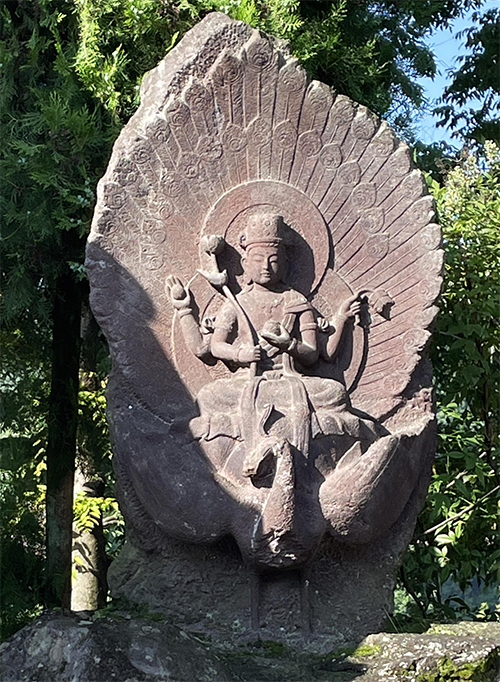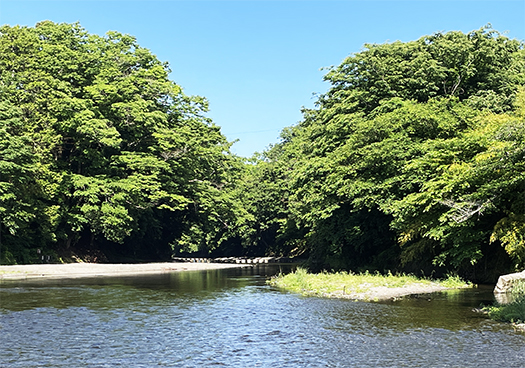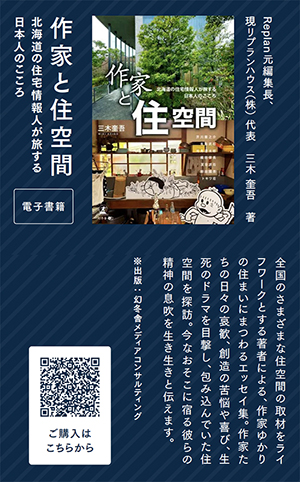

先日「白象が鎮座する鐘楼」について書きましたが、こちらの埼玉県飯能の観音寺の仏像たちにはどうも「好み」を感じさせられていました。やはり白象を設置するという独特の感性が、寺の個性として伝承されるのではないかと。
その象徴的な仏像がこちらの「孔雀明王」仏像。
わたしは別に宗教について深い知見があるとか、仏教美術にこだわりがある、ということではまったくありませんが、好悪という意味ではけっこう数寄なのだと思っています。とくに止利仏師の作である「飛鳥大仏」を拝観して以来、その独特の表情に魅せられ、かれ止利仏師の東大寺に収められている本尊の表情との相似性を強く感じて、日本史に残る感性表現のひとつのわかりやすい極点だと感じ続けています。
さらに額田王がモデルとされた仏像にも強いインパクトを受けさせられていた。仏教がこの国にもたらされて以降、こうした仏像は多くのひとびとの心象に大きく関わってきただろうことは疑いようがない事実。仏像を彫る側も、そしてそれを感受する側も、その作品の雰囲気の部分で、ある共有感があるでしょう。
こちらの「孔雀明王」さんの説明石碑があったので以下に。
〜古来インドでは孔雀は、コブラなどの毒蛇や害虫を食べることから、孔雀明王には人びとの災厄や苦痛を取り除く功徳と、人間の煩悩の象徴である三毒(貪り・○り・痴行〜一字不明)を食らって仏道に成就せしめる功徳があるとされます。また孔雀明王を拝むことで一切の恐怖をなくし、安楽を得させるともいわれます。孔雀明王の御前でご真言をお唱えし、自らの大願成就に向けて、魔除けや煩悩退散の力をお授けくださいますよう、お祈りください。 孔雀明王ご真言。オン マユラ キランディ ソワカ 令和4年 観音侍従職○○〜
「ご真言」というのが突然、宗教的な梵語呪文になっていてまるで、この仏様のありがたいお言葉に聞こえてくる(笑)。まことに真言、なのでしょう。般若心経はわたし暗記して唱えられますが、最後の部分にはこういう「梵語」がやはりもれなく付いてくる。古代インド発祥の素性を明示していますが、この列島社会のひとびとの素直な「受け入れ」姿勢にもいつも驚かされる。たぶんこの辺が心に印象強く沈殿している。
こういった素直さ・従順さこそが日本人らしさの根源なのか?オモシロいなぁといつも感じさせられています。
●お知らせ
拙書「作家と住空間」幻冬舎から電子書籍で発刊
お求めはAmazonで。
https://amzn.asia/d/eUiv9yO

English version⬇
[The “taste” of Buddhist statue installation and its selective eye]
sutras that conclude with foreign Sanskrit words. The attitude of a spirit that accepts a wide range of languages. Is it a Japanese sensibility? And the world-sharing softness of the Buddha image. The “taste” of the sutras.
The other day I wrote about the “bell tower with a white elephant sitting in it,” but the Buddhist statues here at Kannon-ji Temple in Hanno, Saitama Prefecture, gave me a sense of “taste. I thought that the unique sensibility of installing white elephants might be handed down as the individuality of the temple.
The symbolic Buddha image here is the “Peacock Myoo” Buddha image.
I do not have a deep knowledge of religion or a particular interest in Buddhist art, but in terms of likes and dislikes, I am quite a picky person. In particular, ever since I saw “Asuka Daibutsu,” the work of Buddhist monk Toributsuji, I have been fascinated by its unique expression, and I strongly feel that it is similar to the expression of the principal image in Todaiji Temple by Toributsuji, and I continue to feel that it is a simple extreme point of sensitivity and expression that remains in Japanese history.
Furthermore, the Buddhist statue modeled after King Nukata had a strong impact on me. It is an indisputable fact that since Buddhism was brought to this country, these Buddhist statues have had a significant impact on the mental images of many people. Both the person who carves the Buddha image and the person who perceives it will have a certain sense of sharing in the atmosphere of the work.
The following is an explanatory stone inscription of the “Peacock King” here.
〜In ancient India, the peacock eats poisonous snakes and insects such as cobras, so it is said that the peacock has the merit to remove people’s misfortunes and pains and also the merit to achieve Buddhahood by eating the three poisons that symbolize human troubles (greed, covetousness, and lasciviousness – one character is unknown). It is also said that by worshipping the Peacock King, one can eliminate all fear and attain peace of mind. Please recite the Mantra in front of Myoo, and pray that he will grant you the power to ward off evil and dispel troubles and worries in order to fulfill your great desire. The Mantra of the Great Peacock King. On Mayura Kirandi Sowaka, 2022, Kannon Samurai Assistant Office XX~
“Goshinto” suddenly sounds like a religious Sanskrit incantation, as if it were the grateful words of this Buddha (laughs). It must be a true sincerity. The Heart Sutra can be recited by heart, but the last part of the sutra is always accompanied by this kind of Sanskrit. It clearly shows its origin in ancient India, and I am always surprised at the honest attitude of “acceptance” of the people of this archipelago society. Perhaps this is the area that has left a strong impression on my mind.
Is this kind of honesty and obedience the root of Japaneseness? I always find it interesting.
Notice
My book “The Writer and the Living Space” is published in e-book format by Gentosha.
Available at Amazon.com.
Posted on 6月 1st, 2025 by 三木 奎吾
Filed under: 日本社会・文化研究







コメントを投稿
「※誹謗中傷や、悪意のある書き込み、営利目的などのコメントを防ぐために、投稿された全てのコメントは一時的に保留されますのでご了承ください。」
You must be logged in to post a comment.